Kazatomprom plans to increase its production of sulfuric acid - the main reagent used in its in-situ leach (ISL) uranium operations - with the construction of a new 800,000 tonnes per year plant in the Sozak district of Kazakhstan's Turkestan region.

Sulfuric acid is an essential reagent for Kaztomprom's ISL operations (Image: Kazatomprom)
The Kazakh national atomic company said it has received a certificate of state registration for a new partnership enterprise, Taiqonyr Qyshqyl Zauyty LLP, which has been set up to implement the project for the construction of the new plant. The new enterprise was founded by Kazatomprom (49%) and its subsidiaries RU-6 LLP (25%) and Kazatomprom-SaUran LLP (26%). RU-6 carries out ISL uranium operations at the North Karamurun and South Karamurun deposits in the Kyzylorda region, while Kazatomprom-SaUran produces uranium from the Kanzhugan, Yuzhny Moyynkum, Central Moyynkum, Uvanas and Mynkuduk wellfields.
ISL uses a solution of native groundwater fortified with an acid or alkali which is pumped through boreholes to dissolve minerals in an orebody. The solution is then pumped to the surface, where the minerals can be recovered. The method needs suitable geology - with an orebody that is permeable to the liquids used, and located so groundwater away from the orebody does not become contaminated - but requires little surface disturbance and generates no tailings or waste rock. All of Kazakhstan's uranium production today uses ISL methods, using sulfuric acid.
Sulfuric acid is the main reagent used in ISL uranium production in Kazakhstan. Producing its own acid near the mines will allow Kazatomprom to ensure the availability of an additional reliable and long-term source of supply as well as helping to minimse the impact of cost increases and reduce the cost of uranium products, the company said.
A feasibility study of the project is being completed and a potential investor is being selected, Kazatomprom said. Costs will be determined after the approval of the design and estimate documentation. Construction of the sulfuric acid plant is planned to begin in 2024, with start-up and ramp-up to full design capacity expected in 2026.
The project is strategically important both for Kazatomprom and for the Turkestan region, where the plant will make a "significant contribution" to economic and social development, the company said. As well as attracting additional investments and bringing local tax revenues, construction of the plant will create about 800 jobs, and about 500 workers will be needed for its operation. The region will also benefit from electricity that will be generated from byproduct heat from the plant.
According to information from World Nuclear Association, the relatively high levels of carbonate in Kazakshtan's orebodies mean large quantities of sulfuric acid are required: in the past, Kazkah production has faced constraints due to the availability of the acid, until a coordinating council to regulate acid supplies and infrastructure was established in 2009.